Questions
- The figure below shows positions of a ball bouncing on a floor. State the energy changes at C.
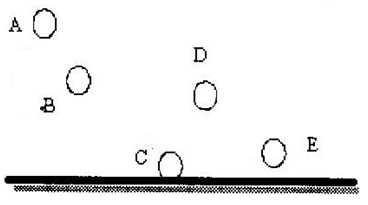
-
- Explain why a burn from the steam of boiling water more severe that of water itself?
- An energy saving stove when burning steadily has an efficiency of 69%. The stove melts 0.03 kg lf ice 00C in 180 seconds.
Calculate: -- The power rating of the stove.
- The heat energy wasted by the stove.
- A pump uses 1g of a mixture of petrol and alcohol in the ratio 4:1 by mass to raise 1000 kg of water from a well 200m deep.
- How much energy is given by 1g of mixture?
- If the pump is 40% efficient, what mass of this mixture is needed to raise the water? (1g of alcohol = 7000J, of petrol= 48000J)
- Suggest two energy changes that accompany the changing of a liquid in a vapour phase.
- A bullet of mass 0.8g travelling at 400m/s is strapped by a concrete wall. calculate the amount of energy transferred to the wall
- A small mass m is suspended freely at the lower end of a spring as shown below.
The mass is displaced by a small distance and then released and allowed to oscillate. What form of energy does the mass have at a point midway between A and B?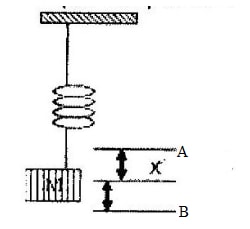
- What makes the amplitude of osculation of a simple pendulum to decrease with time?
- A screw advances 1mm when the screw is turned through two revolutions. What is the pitch of the screw?
- A ball rolls on a table in a straight line. A part from the transitional kinetic energy, state the other form of kinetic energy possessed by the ball.
- A car of mass 800 kg is initially moving at 25 m/s. Calculate the force needed to bring the car to rest over a distance of 20 m.
- A workshop has the following simple machines for lifting heavy loads, a wheel and axle, and a movable pulley. The wheel has a diameter of 30cm while the axle has diameter of 3.0cm.
- Sketch force diagrams to show how each machine works.
- Assuming that the machines are perfect. Calculate the mechanical advantage for each of the machines and show which machine is more advantageous in lifting loads.
- A body has 16 Joules of kinetic energy. What would be its kinetic energy if its velocity was double?
- Define the efficiency of a machine and give a reason why it can never be 100%
-
- The figure below shows a loaded wheelbarrow. Indicate and label on the diagram three forces acting on the wheelbarrow when a worker is just about to lift the handle.
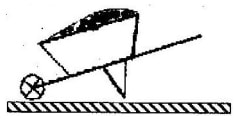
- Suppose the handlebars of the wheelbarrow were extended, which force(s) would change and how?
- The figure below shows a loaded wheelbarrow. Indicate and label on the diagram three forces acting on the wheelbarrow when a worker is just about to lift the handle.
- Sketch a labeled diagram to show how an arrangement of a single pulley may be used to provide a mechanical advantage of 2.
- The figure below shows a force distance graph for a car being on a horizontal ground
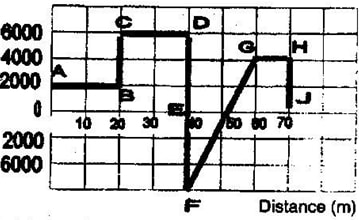
- Calculate the total work done
- If the velocity just before reaching point D is 6m/s, calculate the power developed by the agent providing the force at this point.
- An electric pump can raise water from a lower-level reservoir to the high level reservoir to the high level reservoir at the rate of 3.0 x 105 kg per hour. The vertical height of the water is raised 360m. If the rate of energy loss in form of heat is 200 kW, determine the efficiency of the pump.
- The figure below shows how the potential Energy (P.E) of a ball thrown vertically upwards.
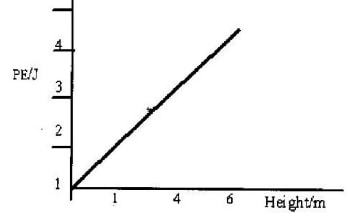
On the same axes, plot a graph of kinetic energy of the ball. - Using a pulley system, a girl lifts a load of 1800N using an effort of 400N. If the system is 65% efficient, determine the velocity ratio of the system.
- A crane lifts a load of 200 kg through a vertical distance of 3.0m in 6 seconds. Determine the;
- Work done
- Power developed by the crane
- Efficiency of the crane given that it is operated by an electric motor rated 12.5 kw.
- A certain machine uses an effort of 400N to raise a load of 600N. If the efficiency of the machine is 75%, determine its velocity ration. (3mks)
- The figure below shows a uniform bar of length 1.0 pivoted near one end. The bar is kept in equilibrium by a spring balance as shown.
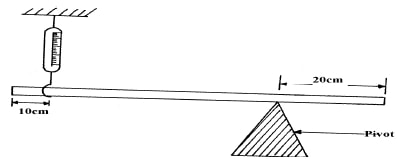
Given that the reading of the spring balance is 0.6N. Determine the weight of the bar. - When an electric pump whose efficiency is 70% raises water to a height of 15m, water is delivered at the rate of 350 litres per minute.
- What is the power rating of the pump?
- What is the energy lost by the pump per second?
- In the arrangement shown, the mass of 30 kg hanging on the pulley helps to raise the unknown load. The person pulling up the other string finds that he had to do 800 Joules of work in order to raise the load 4m.
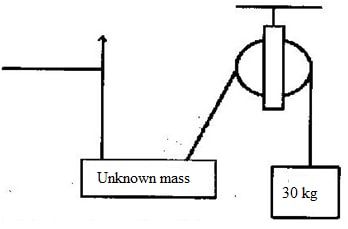
- Calculate the value of the unknown mass.
- State the assumptions you make in calculating the value (a) above
- A load of 100N is raised 20m in 50s. Calculate;
- The gain in potential energy
- The power developed
- Gitonga has a mass of 60kg and climbs up a slop of 200m long and inclined at an angle of 100 to the horizontal. Calculate the minimum work done by Gitonga.
- A force of 8N stretches a spring by 10cm. How much work is done in stretching this spring by 13cm?
- A simple pendulum is released from rest and it swings towards its lowest position. If the speed at the lowest position is 1.0m/s, calculate the vertical height of the bob when it is released.
Answers
- Kinetic- potential – kinetic
-
- Steam has more energy and would release its latent heat of vaporization before turning to water at 1000C.
-
- Q= ml
= 0.03 x 336000
= 10080J
Power output = 10080 = 56W
180
Po x 100 = 60
Pi
56 x 100 = 60
Pi
Pi = 93.33w - E= Pt = 93.33 x 180
= 16,800J
Energy wasted = 16800 – 10080
= 6720J.
- Q= ml
-
- 1/5 g of alcohol will give 2.7 x 104J
4/5 of petrol will give 3.84 x 104 J
∴ 1g of mixture gives
= 5.4 x 103 + 38.4 x 103J
= 43. 8 x 103J - w.d = mgh = 1000 x 200 x 10 = 2 x 106
Energy required = (2 x 106) x 100
40
Mass required = 2 x 107
4 x 43.8 x 103
= 114.2g - P.E → Heat
Heat →K.e
- 1/5 g of alcohol will give 2.7 x 104J
- Quantity of heat = k.e = ½ mv2
= ½ x 0.8 x 10-3 x 400 x 400
= 64J - K.e
- Air resistance causes damping of vibration
- Pitch=distance the screw moves in or out when turned one revolution=0.5mm
- Rotational K.e
- u= 25m/s, v= 0m/s
s= 20m
v2 = u2 + 2as
O= 625 + 40a
a= -15.625 m/s2
F= ma = 800 x – 16.625
= 12, 500N -
-
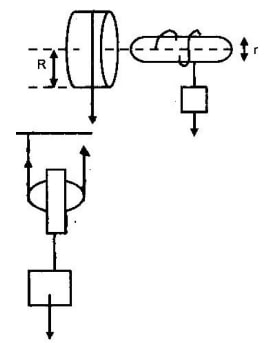
- If E = 100% then M.A = V.R = R/r= 15/1.5 = 10
2E = L or 2 = L/E = M.A
Wheel and axle is more advantageous
-
- 16 = ½ mv2
K.e = ½ m (2V1)2 =
Dividing K.e = 4/16 Ke2 = 64J - Ratio of work output to work input expressed as a percentage.
-
-
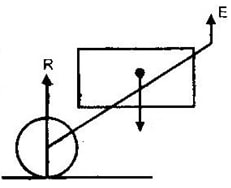
E = Effort
W = Weight
R = Reaction - Effort decreases because the far the force applied is from the pivot, the smaller the value of force required to produce the same moment/turning effect.
-
-
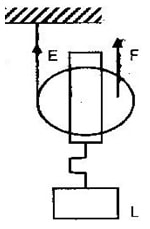
-
- Total work done= area under graph i.e between the x-axis and the line graph w.d = 240000J. (Note that w.d is a scalar quantity and thus the –ve is consider as +ve)
- Power output = mgh= 3 x 10 x 10 x 360 = 300 kW
T 3600
Power input = power output + power loses
= 300 + 200 = 500KW
E = Po x 100 = 300 x 100 = 60%
P1 500
-
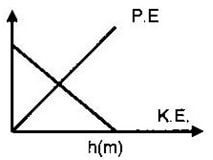
- MA = 1800 = 4.5
400
MA x 100 = 65
VR
VR = 4.5 x 100
65
v.r = 6.9
= 7 -
- w.d = F x d
= 20,000 x 3
= 60000J - P = W.d = 60000
t 6
= 10kw - E= Po/pi x 100= 10/12.5 x 100 = 80%
- w.d = F x d
- MA/VR x 100 = 75%
But MA = 600/400 = 1.5
1.5 x 100 = 75
VR
VR = 2 - Clockwise moments = Anticlockwise moments
0.6 x 70 cm = Wt x 30 cm;
Wt = mg = 1.4 N -
- 1250 W
- 875J
-
- 50kg
-
- 2000J
- 40W
- 2.08 x 104 J
- 0.676J
- 0.05m
Join our whatsapp group for latest updates
Tap Here to Download for 50/-
Get on WhatsApp for 50/-
Download Work, Energy, Power and Machines Questions and Answers - Physics Form 3 Topical Revision.
Tap Here to Download for 50/-
Get on WhatsApp for 50/-
Why download?
- ✔ To read offline at any time.
- ✔ To Print at your convenience
- ✔ Share Easily with Friends / Students

